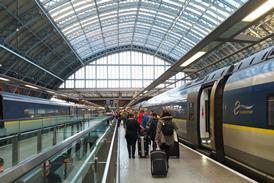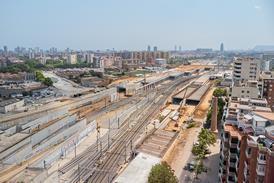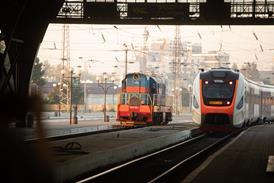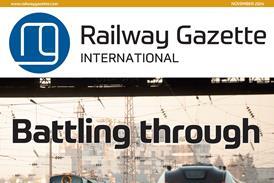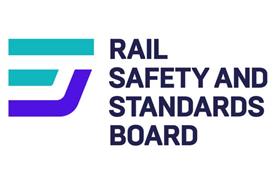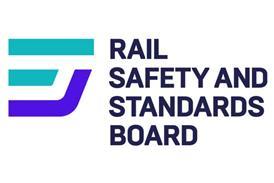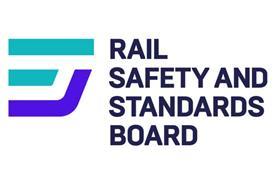INTRO: ATB-NG, the ATP upgrade equivalent to ETCS Level 1 developed for the Netherlands, will not enhance capacity. Faced by 50% growth projections for 2010, passenger operator NS Reizigers believes that only BB21 moving block and civil works to relieve bottlenecks can meet public expectations
BYLINE: Jos Holtzer
Manager, Department of Infrastructure PlanningNS Reizigers
NS REIZIGERS, the organisation within Netherlands Railways responsible for passenger operations, faces a major challenge in coping with rapidly rising demand on a network that is still largely double-track. In 1998, passenger-km reached an all time high of 14879 million. It is forecast to be 25% more in 2005, and 50% higher in 2010 - assuming, of course, that there is enough capacity on the trains and tracks.
There has been much debate about the most economical way to generate that capacity. It is accepted that the signalling system, the ATB automatic train protection based on coded track circuits introduced in 1954, and the Telerail train radio network, must be replaced over the next few years. GSM-R cellular radio will definitely replace Telerail by 2003.
Although there has also been much discussion about converting from 1·5 kV DC traction to 25 kV AC, which would require complete resignalling, no decision has been reached.
Development of an innovative train control and command system started in the 1980s. The main focus was not on high-speed operations, but on increasing the capacity of the network by intensifying use of existing tracks rather than adding more infrastructure. This made development of a new, smart ATP/ATC system imperative. The system to be developed became known as BB21, meaning ’enhanced utilisation in the 21st century’.
In the early 1990s, a McKinsey study underpinned the prevailing view that intensification of existing track use was an adequate way of enhancing capacity, avoiding the need for heavy expenditure on civil engineering. A further study by Railned, the government agency responsible for optimising the current and future use of the national rail infrastructure, suggested that an increase in line capacity of 10% to 25% appeared to be possible using BB21. As a result, Railned is now investigating various scenarios for migration from the present situation to one using BB21.
The fact that BB21 promises an increase in line capacity should be good news for train operators, for they find themselves in a tight situation. This applies not only to NS Reizigers, but also to NS Cargo and other operators that are beginning to appear as a result of open access policies.
The Dutch network, already the most densely used in Europe, is stretched to the limit. On a number of main lines, track occupation today is far above the UIC desirable norm of 75% of the theoretical capacity.
Most lines are only double track and shared by stopping, inter-city and freight trains. The inevitable result is inefficient use of capacity, with any delays rippling swiftly across the network. Adding more trains to a service that already functions below the required standards of reliability and punctuality is virtually impossible.
BB21 and 25 kV not enough
Improving the overall performance and capacity of the rail network within an affordable investment profile has become a prime objective of the Dutch government, Railned, NS Railinfrabeheer (which maintains the infrastructure) and the train operators. There is a general consensus that this involves strengthening the power supply, eventually replacing the 1·5 kV DC system by 25 kV AC and implementing BB21. The main question today is whether BB21 and 25 kV alone suffice to meet the requirements. The answer is a clear ’no’.
First of all, theoretical track capacity is not the only constraint. There are strict regulations concerning noise emission in certain areas. Others govern the minutes within each hour that a level crossing can be closed. Intensifying occupation of the track means breaking these rules in quite a few cases, raising legal hurdles.
Then there are several plans for the development of dedicated light rail systems in and around the major centres of the country. Making use of conventional lines to reduce costs is considered a viable option. Because light rail vehicles have their own running characteristics, less efficient use of capacity will be the result.
Junction and platform occupation are becoming real bottlenecks lately, and BB21 can do little to help. Even if it could, passenger handling at interchange stations would be the next barrier. With a further increase in train frequencies and passenger numbers, we are taxing the ability of stations to accommodate large numbers of people to the point where this could constrain network capacity - a situation that London Underground, for instance, is quite familiar with.
This means that without investment in civil engineering works for noise reduction, elimination of level crossings or expanding passenger capacity at stations, the impact of a new train control and command system will remain limited. But in any event, it will be very difficult to absorb traffic growth of 50% or more with a 10% to 25% increase in line capacity.
Why more tracks are needed
Train operators believe the main benefits of BB21 are to be found in more flexible and reliable regulation of traffic when services are disrupted. The extra capacity gained by BB21 is thus used to secure better punctuality.
To make a real step forward in running more trains, double-track bottlenecks (mainly in the Randstad area) must be quadrupled. This enables high speed, inter-city and freight trains to be segregated from commuter and light rail trains, exploiting the true value of ERTMS/ ETCS Level 2 and 3 systems. The cost advantage is that in place of former plans for six or even eight tracks, four will do the job with BB21. Outside the Randstad area, BB21 helps to get rid of tight spots without the need for heavy investment in infrastructure.
So BB21 can be of great value - always providing, of course, that the system works as it should. It must be remembered, in this context, that BB21 has to cope with quite a number of technical problems. Here are just two examples.
The potential danger of not achieving higher train densities with BB21 became apparent after drivers on lines equipped with the new ATB-N(ew) G(eneration) automatic train protection system were increasingly confronted with serious inconsistencies between lineside signals and cab displays. ATB-NG in essence offers ERTMS Level 1 functionality, and has influenced the ERTMS/ETCS specification process in a number of ways. After a thorough investigation, it was established conclusively that the problem was inherent to the basic design and characteristics of the system, and cannot be resolved.
The main reason is that on-track design, especially the location of balises, relates directly to running and braking characteristics of the principal train type using the line. Once these parameters are changed, balises will be in the wrong place and the cab display will conflict with the driver’s view of lineside signals. A Level 1 system, therefore, is not suitable for mixed traffic lines.
But there is an even more serious problem to be dealt with. It is generally assumed that Level 2 or 3 moving block systems will allow more efficient use of capacity because block length becomes flexible, and headway can be reduced to the theoretical minimum. The ATB-NG study showed, however, that the headway exceeded the normal standard block length in quite a few cases, making it less efficient than ATB. In the case of ATB-NG, a safe braking procedure is followed, and to a large extent this is determined by the time needed for the pneumatic brakes to react to the driver’s commands.
One alternative could be to base headways on the relative braking distance required by successive trains - which in practice is what tends to happen on a busy motorway. However, the Eschede accident emphasised the need to retain the traditional railway practice of assuming that trains can stop instantaneously in an accident. Another option could be to replace pneumatic by hydraulic braking systems. Reaction time would be much shorter, but costs for the rolling stock owner much higher.
But the main point is that the ATB-NG braking curve, already steep in a European context, still does not demonstrate conclusively the efficiency and effectiveness of the new system in terms of raising line capacity. Does this mean that enhanced utilisation is out of reach?
Certainly not! But these examples do show that new ground has to be broken to secure the objectives Railned and RIB have set themselves. Braking curve computation and related problems should be at the focal point in the development of ERTMS/ETCS systems.
Split responsibilities
Responsibilities for infrastructure and operations have been effectively split between RIB and Railned on the one hand - both financed and controlled by the government - and train operators who are expected to operate as commercial businesses, even when still state-owned.
The essence of ERTMS/ETCS is that trains are made highly intelligent to put as little functionality in the track as possible. So cost of the on-board equipment increases while that on the track falls, showing a favourable economic balance in the end. But whose ’balance’ are we talking about now? Obviously, the public sector (infrastructure) side is more convinced of the advantages of BB21 then the private sector train operators, who seek tangible and unequivocal proof of the payback from BB21.
This dichotomy poses a serious threat to swift introduction of new systems generally, not just BB21. A few years back, Railned studied network conversion from the present 1·5 kV DC to a 25 kV 50 Hz power supply (RG 8.97 p517). The study showed that a quick conversion would be a good way to tackle the power upgrade problem at reasonable cost in terms of infrastructure.
However, costs for adapting the rolling stock (part reconstruction, part replacement) were estimated at several billion guilders. Not surprisingly, operators were less than enthusiastic, and countered by opting for gradual replacement of 1·5 kV by dual-voltage rolling stock, and replacement of the existing catenary by one fit for both voltages. A deal between government and operators, compensating the latter for the extra costs with which they are confronted, would be very helpful in addressing this problem.
Mega projects
We see quite a number of new lines under construction in Europe. In the Netherlands, these mega projects are the Betuwe line, a dedicated freight line connecting the port of Rotterdam with the German hinterland, and the high speed line from Amsterdam to Antwerpen for Brussels and Paris (HSL-Zuid). Also qualifying for mega status is Amsterdam to K"ln and Frankfurt (HSL-Oost). This corridor is to be upgraded for higher speeds, and as a first phase the Amsterdam - Utrecht line will be quadrupled.
Construction of the Betuwe line has started and the line should be in service by 2005. Final preparations are being made for the other two megas. HSL-Zuid is to be operational in 2006 and the first phase of HSL-Oost between Amsterdam and Utrecht in 2007. This means effectively that the first release of proposed Level 2 or 3 train control system to be used on the megas has to be available in 2001!
In the Netherlands, as in most European countries, the availability of a new generation of ETCS/ERTMS train control and command system thus lies on the critical path of these strategic projects.
The development of an ETCS/ ERTMS compliant train control and command system for the megas is now well under way. Railinfrabeheer is on the verge of signing contracts with Adtranz and Alstom for the development of an innovative ATP system suited for high speed operation.
But more is needed. For one, the 1·5 kV power supply cannot support speeds above 200 km/h. A 25 kV alternative, starting with HSL-Zuid and the Betuwe line, is being studied.
Maybe even more important are the VPT+ and especially the VPT2 projects. They constitute a major improvement in the VPT control and command system currently in use on the Dutch network, and are to enhance capacity. VPT+ will provide traffic management for the megas, and must guarantee smooth operation of high speed and conventional traffic alike.
Finally, roll-out of GSM-R radio infrastructure for the entire network is planned between 2001 and 2003. But what the programme lacks thus far is specific measures to enhance track capacity.
Capacity must increase
Increasing the capacity of our rail network is vital to all stakeholders. Otherwise, even the short term expected growth of passenger as well as freight traffic simply cannot be accommodated.
Replacement of ATB and VPT by new and innovative Level 2 or 3 systems can certainly contribute to better and more efficient utilisation of the infrastructure now available. But it is imperative that even more capacity is provided during the next decade.
Considerable investment in engineering works will be necessary to avoid a meltdown of the railway system in the long term. These works concern not only the traction power supply, platform line capacity and transfer facilities in stations. To really catch up with demand, physical extension of the railway network must be addressed as well.
CAPTION: The ability of platforms and subways to handle passengers interchanging at major stations like Utrecht is becoming a serious constraint on network capacity
CAPTION: Some bottlenecks such as Gouda have been dealt with, but substantial quadrupling of key routes will be needed if a 50% increase in passenger-km is to be handled
CAPTION: The need to convert or replace rolling stock to cope with BB21 and 25 kV traction supplies at a time when demand is rising poses a major problem for passenger operator NS Reizigers
Summary in French, German and Spanish:
NS Reizigers needs ETCS and new lines to handle growth
Faced by 50% growth projections for 2010 on Netherlands Railways, the state-owned passenger operator believes that only the BB21 moving block system coupled with substantial civil engineering works at stations and bottlenecks can meet political and public expectations for relief of mounting road congestion. Even then, some new lines will be needed. Upgrade of the 1950s ATB automatic train protection system to ATBNG, which relies on balises, does little to enhance capacity and may even reduce it by forcing drivers to brake even when they can see green signals ahead.
NS Reizigers a besoin de l’ETCS et de nouvelles lignes pour faire face ... la croissance
Confronté ... un accroissement du trafic de 50 % projeté pour 2010 sur le réseau néerlandais, l’opérateur voyageurs, NS Reizigers, pense que seul le block ... cantons glissants associé ... des travaux substantiels de génie civil dans les gares et aux goulets d’étranglement parviendra ... satisfaire les attentes ... la fois politiques et publiques, afin de d’enrayer la paralysie d’un trafic routier qui augmente. Malgré tout, quelques nouvelles lignes seront nécessaires. La version améliorée ATB-NG du système ATB de protection des circulations datant des années 50 fait appel ... des balises au sol mais n’aura que peu d’influence sur l’amélioration de la capacité; cette dernière pourrait même diminuer, le nouveau système forçant les conducteurs ... freiner alors qu’ils pourront voir les feux verts bien loin, ... l’avant du train
NS Reizigers braucht in Zukunft ETCS und Neubaustrecken
Die staatliche Personenverkehrsgesellschaft NS Reizigers steht Wachstumsprognosen auf dem Netz der Niederländischen Eisenbahnen von 50% bis zum Jahr 2010 gegenüber. Sie glaubt, dass nur mit dem Beweglichen Block-System BB21 in Verbindung mit substantiellen Bauarbeiten in Bahnh"fen und den bekannten Flaschenhälsen den Erwartungen von Politik und Allgemeinheit entsprochen werden kann. Aber sogar dann werden gewisse Neubaustrecken notwendig sein. Das Aufrüsten des aus den 50er-Jahren stammenden Zugsicherungssystems ATB auf ATB-NG, welches mit Balisen arbeitet, trägt wenig zur Kapazitätssteigerung bei, ja kann diese sogar verringern, indem sie den Lokführer zu einer Bremsung zwingt, wenn er auch einem offenen Signal begegnet
Para enfrentar el crecimiento NS Reizigers necesita del ETCS y nuevas líneas
Enfrentados con proyecciones que indican un crecimiento del 50% para el año 2010 en los Ferrocarriles Holandeses, el operador de pasajeros estatal sostiene que solamente el sistema de bloqueo móvil BB21 junto con un substancial programa de construcción en las estaciones y los puntos de estrangulamemto es capaz de satisfacer las expectaciones públicas y políticas para el alivio de la creciente congestión de tr fico en las carreteras. Incluso así, ser necesario la construcción de nuevas líneas. La modernización del sistema de protección autom tica de trenes ATB de los años 50 al ATB-NG, el cual emplea balizas, no ayuda mucho en aumentar la capacidad e incluso hasta la puede reducir al forzar a los conductores a frenar aun cuando ven aspectos de vía libre adelante

